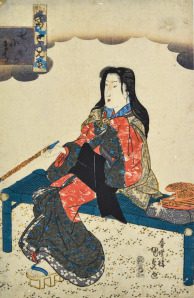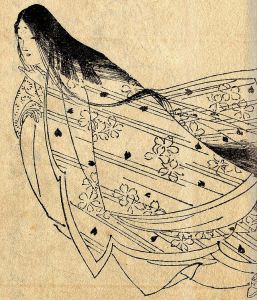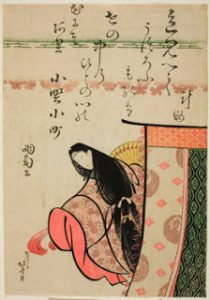Waka Poetry in Old Japan: Ono no Komachi and Myths
Lee Jay Walker
Modern Tokyo Times
The waka poet, Ono no Komachi, is a noted poet in Japan. This reality is abundantly clear because Komachi is numbered within the Thirty-six Poetry Immortals in the land of the rising sun. Komachi, according to tradition, was born in 825 and passed away in the year 900. However, it must be stated that the actual birthplace of Komachi and her death remains open to debate. Therefore, while she firmly belongs to the ninth century certain doubts remain about important aspects of this famous waka poet.
In her days of youth and well into mid-life Komachi was known for her stunning beauty and this reality would become embodied within various noh plays – and other areas of Japanese high culture. Sadly, while the obvious theme of these plays focus on her waka poetry, the same plays also indulge about her vanity and wayward spirit in relation to various acclaimed affairs.
Of course, noh plays, and others areas of culture including Japanese woodblock prints, often delved into other areas based on entertainment. Or in the case of art, then the need to illuminate important characters so that they would fall naturally into the world of ukiyo-e. Naturally, given the abundant talents of Komachi – in relation to the Heian period – alongside her noted beauty, then noh plays had much to indulge themselves.
However, how much truth can be found within literature, Japanese woodblock prints, noh plays and other areas of culture is debatable. Yet, the famous noh plays titled Komachi Soshi, Komachi uta Arasoi, Sotoba Komachi, Sekidera Komachi and Kayo Komachi – alongside ukiyo-e and other important areas of culture and entertainment – have kept Komachi alive. Therefore, vast numbers of people are still intrigued about this important Japanese figure in history.
The Toshidama Gallery, an amazing source for Japanese art knowledge and a place blessed with stunning Japanese woodblock prints, highlights an unusual art piece that focuses on positive areas. Toshidama reports about an amazing art piece by Utagawa Kunisada by stating: “This captivating print has all the qualities of the outstanding images of women in Japanese art in the first half of the nineteenth century. The figure is static, carrying the deftness of the line, the composition, the drawing and the balance of the image. There is a density in the collision of pattern in the clothing that tends to flatten the subject and the face is a masterpiece of economy and design. The print is a mass of sophisticated technique and inventive design – here the mottled foreground stands in for solid earth but doubles as a compositional device, balancing the schematic clouds at the top of the picture and being confined by the awkward thrust of the bench that supports the decorative figure, penetrating the neutral, centre field.”
Toshidama continues: “Importantly, the subject of the print engages the knowing viewer because it is a mitate – something standing in for something else or else a commentary upon it. Ono no Komachi was a highly esteemed Japanese poetess of the ninth century. She is famous in Japan still as one of the 106 immortal poets. Her appearance here as a fashionable young beauty has more to it than meets the eye. There are seven famous stories about Komachi, some of which have become noh dramas – theatrical high culture. In all of these pieces Komachi is portrayed as an old hag; regretful of her former beauty and the many loves she has enjoyed. In fact Komachi was known also for her great beauty and her later representations are a result of moralising Buddhist orthodoxy. In this print Kuniyoshi illustrates a story known as The Gravepost. A group of priests come across an old beggar woman sitting on a wooden grave marker (sotoba). They try to chase her away, chanting scriptures at her. She replies with more learned quotations and the priests are surprised and bow low in apology. She reveals that she is Ono Komachi, the once beautiful and famous poetess. She is seized then by the ghost of Fukakusa, the suitor whom she had forced to visit her for one hundred nights to gain her love. She reenacts his miserable visits and subsequent death, in a dance.”
In other words, Kunisada can be viewed to be using a more enlightened approach because unlike elements of high culture that chided Komachi, he focuses on her beauty from a different angle. Therefore, the morality of Buddhism – and Confucianism – that played a powerful moral code within the realm of culture and other areas of society becomes relegated by a fresh approach.
Indeed, it may well be that noh plays merely highlight a reality that only exists within mythology and stereotypes. In this sense, the charming beauty of Komachi and her acclaimed waka poetry is being relegated by perceived worries that are meant to worry females of the status applied to Komachi. Yet in truth, it may well be that age added a new dimension to the many talents that Komachi was blessed with.
It is best therefore for Komachi to be remembered by the richness of her poetry because this is where her true legacy belongs. Komachi wrote:
| Fana no iro Fa uturi ni keri na itadura ni waga mi yo ni Furu nagame sesi ma ni |
The colour of this flower Has already faded away, While in idle thoughts My life goes by, As I watch the long rains fall. |
In another lovely poem that highlights the rich passion and deep thoughts of Komachi she expresses:
| kokoro kara ukitaru Fune ni norisomete FitoFi mo nami ni nurenu Fi zo naki |
Upon my breast Floats a boat of heartbreak And I have just embarked; There’s not a single day when waves Do not soak my sleeves. |
It is these amazing poems that continue to show the real power of Komachi. After all, they continue to illuminate despite the longevity of time. Therefore, irrespective of the reality of the “real Komachi,” it is clear that her words do all the real talking.

Modern Tokyo News is part of the Modern Tokyo Times group
DONATIONS to SUPPORT MODERN TOKYO TIMES – please pay PayPal and DONATE to sawakoart@gmail.com
http://moderntokyotimes.com Modern Tokyo Times – International News and Japan News
http://sawandjay.com Modern Tokyo Times – Fashion
https://moderntokyonews.com Modern Tokyo News – Tokyo News and International News
http://global-security-news.com Global Security News – Geopolitics and Terrorism
PLEASE JOIN ON TWITTER
https://twitter.com/MTT_News Modern Tokyo Times
PLEASE JOIN ON FACEBOOK
https://www.facebook.com/moderntokyotimes
Some Japanese art and cultural articles by Modern Tokyo Times are republished based on the need to inform our growing international readership about the unique reality of Japan.
Modern Tokyo Times
This article is written based on the supreme kindness of Kanako Mita who continues to support Modern Tokyo Times through thick and thin. Therefore, this is a small thank you in appreciation of all your support.


